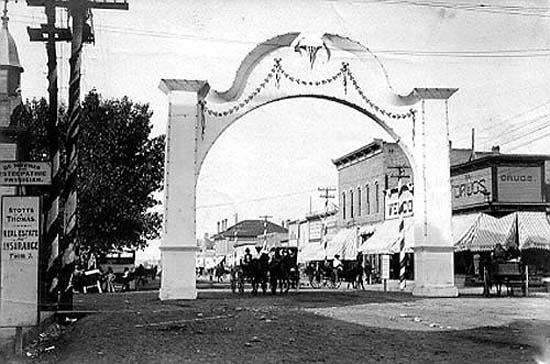
Welcoming Arch, 1903 Industrial Fair, photo by B. C. Buffum.
Photo courtesy of and copyrighted by Ben and Mary Sue Henszey.
For discussion of B. C. Buffum, see Frontier Days.
The 1903 Industrial Fair is regarded as a predecessor of today's State Fair in Douglas. The drug store on the
right at 1-7 South Main is still in existence and is only false-fronted building left today on Main Street. On the front of the building today is
a mural of the building's appearance when first constructed. The building was constructed in
1883 as a J. H. Conrad & Co. store.
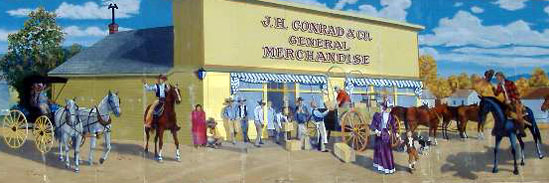
Mural of J. H. Conad & Co. Store
John H. Conrad had been the post trader at Fort McKinney and later
became a prominent banker, stockgrower, and merchantilist in Montana. There he had asperations of becoming governor. Conrad also operated a store at Buffalo.
He sold the business to C. W. Hine and J. M. Lobban but their business failed in the panic of 1893. In 1891, Conrad was responsible for
obtaining evidence which resulted in the trial of Dr. Thomas Thatcher Graves for the
"Murder by Mail" of Conrad's mother-in-law, Josephine A. Barnaby. Conrad's father-in-law was a wealthy Rhode Island
merchant and Democratic Party politician. When Mr. Barnaby died, Josephine A. Barnaby was in poor heatlh and allowed
Dr. Graves, an unlicensed physician, to gain control over her fortune.
In April 1891, Mrs. Banaby was visiting a friend in Denver. There, Mrs. Barnaby died after drinking poisoned
whiskey that she had received as an anonymous gift. The whiskey had been
mailed from Boston. The whiskey proved to have been laced with a solution of
arsenite of potasium. Conrad suspected Dr. Graves in Providence. Conrad employed the Pinkerton Agency.
Accompanied by several Pinkertons, Conrad travelled to Boston and Providence. Evidence was adduced that the postage stamps on the
package were, at the time, not yet on sale in Boston, but were available in Providence; that Dr.
Graves was in Boston at the time the package was mailed; Mrs. Barnaby's fortune was being looted by the
doctor and that several days before the package had been mailed, Dr. Graves received on behalf of
Mrs. Barnaby $80,000 which Dr. Graves converted into bearer securities. Dr. Graves was aware that Mrs.
Barnaby had consulted an attorney. In Providence, Conrad secured an admission, later denied by Graves,
that Graves had mailed the whiskey. Graves contended that the poison must have been put in the whiskey by Mrs.
Barnaby's friends in Denver. The turning point in the four-week trial, was the production of a witness from Boston who testified that
he wrote the anonymous message that accompanied the package and identified Dr. Graves as the one who asked him
to write the message. Dr. Graves was sentenced to hang. The judgment was overturned by the
Colorado Supreme Court for retrial. See Graves v. People, 18 Colo. 170, 32 P. 63 (1893). While awaiting retrial, Dr. Graves committed suicide in the
Denver Jail using poison.
Directly across the street at 50 N. Main is the Bank of Commerce which also housed the Masonic Temple.
Across the street to the right is the Sheridan
National Bank. The drugstore at the right in the photo
is now the site of the Kendrick Building constructed by John B. Kendrick, governor and
U. S. senator. For biographical information on Kendrick, see
Cattle II. In 1914 the Sheridan National Bank moved into the Kendrick
Building.
Down the street is the town hall with the cupola.
On the bottom floor was the fire station and the upper floor housed the
police department and court room. Behind the Town Hall was located a
corrigated iron jail, notorious for its ease of escape. Among those who escaped was Daniel
Boone Potter. Potter, going by the name "Donnelly," was wanted in North Carolina for the murder
of a deputy sheriff who attempted to serve Potter with a warrant for "forceful trespass." Potter shot the
deputy who expired several weeks later. Potter fled first to Colorado and later to Sheridan where he
was arrested by the town marshal. Potter escaped from the Sheridan jail by breaking a lock, but was
recaptured three days later. When North Carolina authorities arrived, the town marshal refused to
turn Potter over to them until they paid the award. This generated various telegrams from
Sheridan to the North Carolina Governor's office in Raleigh, from Raleigh to Ashville where the governor
was sojourning, and then from the North Carolina Governor to Governor Chatterton in Cheyenne before the matter
could be resolved. when Potter arrived back in North Carolina he again escaped using the same method of breaking
the lock on the cell with an irom bar taken from the cell's plumbing. He as killed by a posse the
following year.
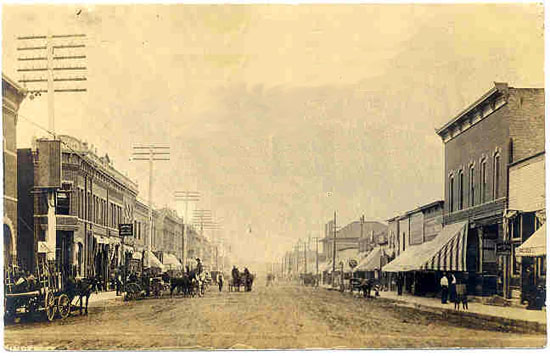
Commercial buildings on Upper Main Street, 1908.
Note absence of trolley tracks. In the next photo the Trolley has been added but the street is still unpaved.
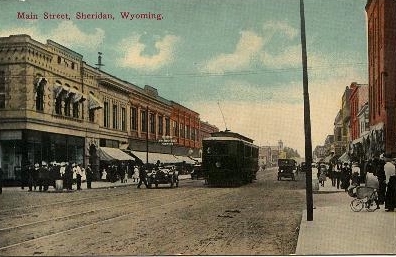
Sheridan, Main Street, approx. 1912
The street railway company was organized in 1910 and provided service from the Western
Hotel to Fort Mackenzie and to the mining camps north of town. The building on the corner is the Diefenderfer and Dinwiddie Hardware Store at
55-59 N. Main. Further down the street at 35 N. Main is the Stevens Fryberger Building
housing the "New York Store." See also next image.
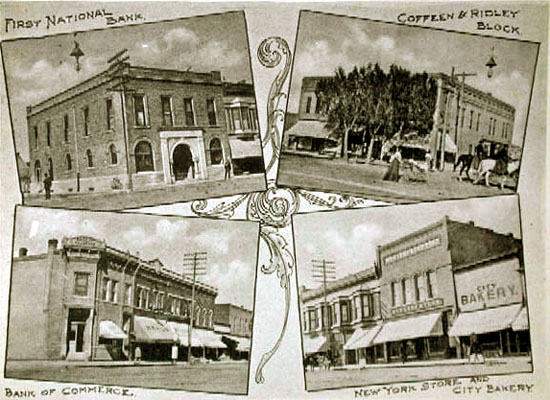
Commercial buildings on Upper Main Street, 1902, card published by Glafcke and Morris
The New York Store claimed to be the largest department store in the state. The term "New York Store" was utilized in
many areas of the west as denoting a particular method of operation as opposed to being a
part of a nationwide chain of "New York Stores."
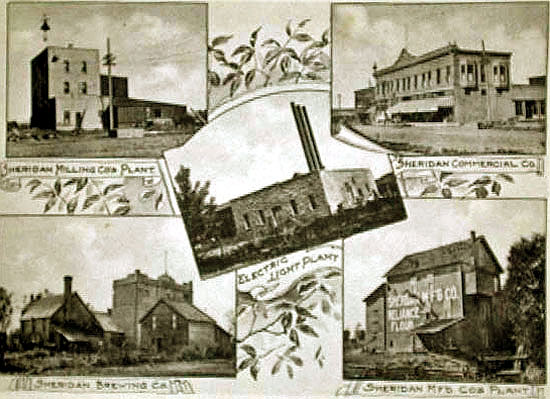
Industrial buildings, Sheridan, 1902, card published by Glafcke and Morris
Ludlow Burleigh Glafcke served as mayor of Sheridan in 1909. His brother, E. W. Glafcke, served in the
U. S. Geological Survey and was responsible for surveying portions of the
Bighorns. Their father, Herman Glafcke, a prominent Republican, was Territorial Secretary 1870-1873, and
later editor of the Cheyenne Leader. Herman Glafcke, named another son Grant Glafcke after
President Grant.
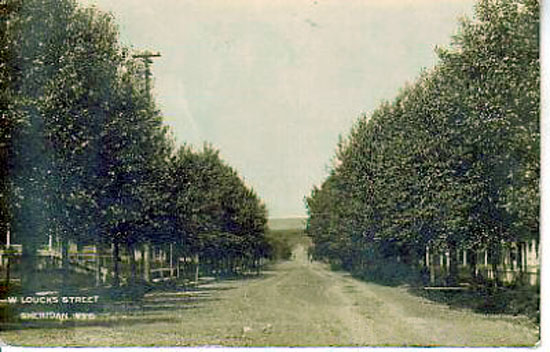
Loucks Street, 1909.
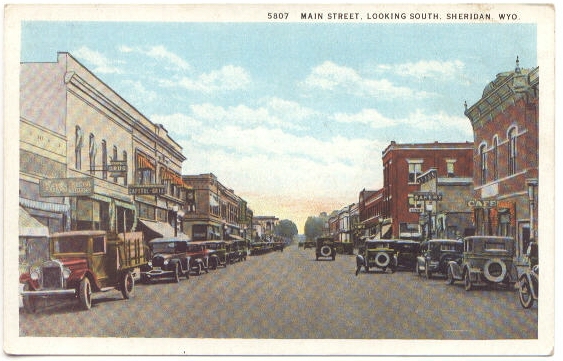
Sheridan c. 1930, looking south to intersection with Brundage.
Compare with photos above. Trolly tracks have now
been removed. The drug store in the panoramic photo is gone and has been replaced
with the Kendrick Building. Beyond the old Bank of Commerce Building, the two wooden buildings
have been replaced with the Lotus Theatre at 42 N. Main. Next door to the Lotus is a Greek restaurant known as the
Lotus Cafe.
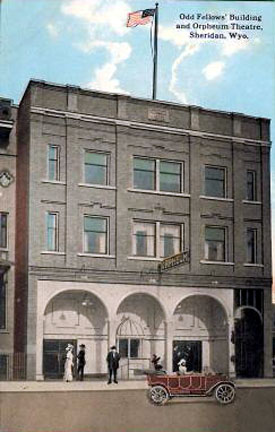 . . . . . .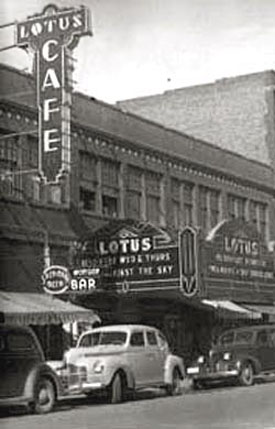
Left, Orpheum Theatre; Right, LOtus Theatre
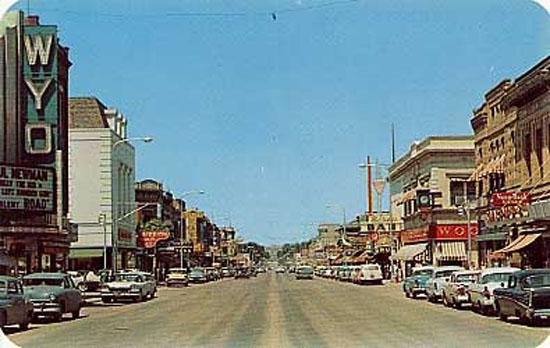
Main Street looking north, 1958, WYO Theatre, formerly the Lotus, on left.
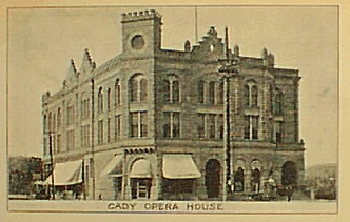 Cady Opera House, 1893
The Lotus opened in 1923 and featured seating for more than 480. The 15-piece Lotus
Orchestra provided accompaniment to the silent movies of the era. In 1929, the
theatre introduced "talkies," with persons coming from all over northern Wyoming to
witness and hear the miracle. During the 1930's the theatre was known as the
Fox-Lotus. In 1941, its owner, Fox Intermountain Theaters, renamed the facility the
WYO. In 1982, the theatre closed, but was purchased in a community effort, restored, and
remains in operation today with live performances.
Cady Opera House, 1893
The Lotus opened in 1923 and featured seating for more than 480. The 15-piece Lotus
Orchestra provided accompaniment to the silent movies of the era. In 1929, the
theatre introduced "talkies," with persons coming from all over northern Wyoming to
witness and hear the miracle. During the 1930's the theatre was known as the
Fox-Lotus. In 1941, its owner, Fox Intermountain Theaters, renamed the facility the
WYO. In 1982, the theatre closed, but was purchased in a community effort, restored, and
remains in operation today with live performances.
Sheridan has had theatres from almost its
beginnings. In the 1890's the very elaborate Italianate-Gothic Cady Opera House opened and
featured vaudville and plays that were traveling the national circuit. In 1906, a fire destroyed the
third floor. The third floor was removed and never restored. The building was
subsequently used as the Helvey Hotel. Appearing at the time of the fire was the national
tour version of the musical comedy The Runaway Match. So the title's pun will not be missed,
the heroine was a "Nellie Matche." A "runaway match" is an elopement.
Other theatres included the Grand, the Orpheum, the Pastime, Gem, Reel, and Star. During the age of
silent movies, most augmented the film with piano music. An exception was the Orpheum located on West Brudage.
The Orpheum installed a
Robert-Morton Theater Organ in 1918. In remembrance of the days of the mighty theatre organ, background
music on this page is from the 1921 Famous Payers-Lasky silent movie "The Sheik" starring Rudolph Valentino as
it might have been played on the mighty Robert-Morton Theater Organ.
Next Page, Sheridan Continued.
|